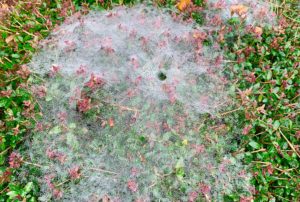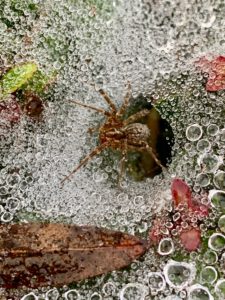
by Mary Reid Barrow
It’s hard for anyone on an early morning walk to miss the sparkling funnel spider webs that adorn the shrubs and grassy areas this time of year.
The dew covered webbing looks especially pretty, more like sequined tulle, on these recent cool, foggy mornings.
It’s easy to pass off these glittery webs as just another spider web. There are so many webs everywhere this time of year.
But these webs deserve a second look. Go close and peer down at one of the webs and learn the story of the funnel spider.
In each web you should see a small hole. The hole is the spider’s “funnel” to its home underneath and how it got its name. If you are lucky, you also may see the resident spider peeking out of its funnel door to view its domain.

The spider, less than an inch long, lies in wait for unsuspecting insects to become snared in the glistening web. The spider has been on guard most of the night and as the morning wears on, it will stop hunting.
But since the dew makes the webs especially visible, whether on the grass on shrubs, in the early morning, hopefully you can take a good look at one before the spider calls it a night:
Grass spider is the common name for the funnel spider species that is most prevalent around here. You may have heard of another funnel spider species, the dreaded Australian funnel spider that has a deadly bite. Never fear. That’s not our spider.
Walk slowly up to a web and peer down to see if you can pick out the little spider at the door to its home. Be careful. if your shadow looms over it or you move too quickly, the critter disappears right back down into its funnel home.
The brownish female, subtly striped on its back and around its legs, will lay eggs soon. The babies will winter over in their egg sac attached to maybe a nearby shrub or branch.
Youngsters hatch in spring and begin building their own little webs in the area. You might not notice them at first, but by late summer or early fall, their webs will be big and sparkly in the morning dew, just like their mama’s was, and the cycle starts anew.
Do you have a favorite tree or plant with a story to tell? What relationships have you observed between plants and critters? Who eats whom? Who has babies where? Send an email to maryreid@lrnow.org